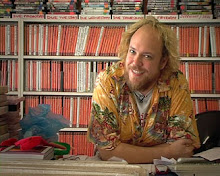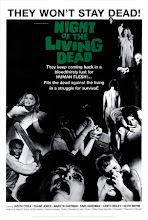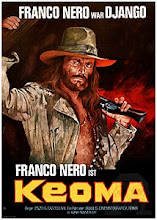 The Blood Drinkers
The Blood Drinkers aka Kulay Dugo Ang Gabi, The Vampire People, Color Of Night, Blood Is The Color Of Night
Director Gerardo de Leon Writer Cesar Amigo
Cast Ronald Remy (Dr Marco), Amalia Fuentes (Charito/Katrina), Eddie Fernandez (Victor de la Cruz), Eva Montes (Tanya, the vampire bride), Paquito Salcedo (Elias, the guardian), Renato Robles
 The Sixties saw a revival of the gothic horror tradition thanks to Hammer’s Dracula series starring Christopher Lee, and a smorgasbord of Continental shockers like Black Sunday and The Horrible Dr Hitchcock. The last place you’d expect gothic to thrive is the
The Sixties saw a revival of the gothic horror tradition thanks to Hammer’s Dracula series starring Christopher Lee, and a smorgasbord of Continental shockers like Black Sunday and The Horrible Dr Hitchcock. The last place you’d expect gothic to thrive is the
 Ronald Remy is striking as the complicated villain Dr Marco, as bald as Nosferatu in dark glasses and snappy 60s black outfits, and simultaneously terrorizing a secluded jungle village while pining for his dying vampire love Katrina. As well as a vampire, he’s a man of science and medicine, and with the help of his hunchbacked assistant and mute dwarf, he plans to transplant the still-beating heart of the village girl Charito into Katrina (both played by the gorgeous 60s Filipino starlet Amalia Fuentes). Modern technology and traditional faith are constantly juxtaposed in a film which cuts between colour film and black and white footage tinted in cool blues and blood red. Apparently colour stock in the
Ronald Remy is striking as the complicated villain Dr Marco, as bald as Nosferatu in dark glasses and snappy 60s black outfits, and simultaneously terrorizing a secluded jungle village while pining for his dying vampire love Katrina. As well as a vampire, he’s a man of science and medicine, and with the help of his hunchbacked assistant and mute dwarf, he plans to transplant the still-beating heart of the village girl Charito into Katrina (both played by the gorgeous 60s Filipino starlet Amalia Fuentes). Modern technology and traditional faith are constantly juxtaposed in a film which cuts between colour film and black and white footage tinted in cool blues and blood red. Apparently colour stock in the
 De
De
 Both The Blood Drinkers and de Leon’s 1966 follow-up Curse Of The Vampires were sold to the world by
Both The Blood Drinkers and de Leon’s 1966 follow-up Curse Of The Vampires were sold to the world by
USA/Philippines 1968 colour
aka Brides Of Blood Island, Brides Of Death, Brides Of The Beast, Grave Desires, Island Of The Living Horror, Orgy Of Blood, Terror On Blood Island
Directors Gerardo de Leon, Eddie Romero Producers Kane W. Lynn, Eddie Romero
Cast Kent Taylor (Dr. Paul Henderson), Beverly “Hills”/Powers (Carla Henderson), John Ashley (Jim Farrell), Eva Darren (
 The lure of the
The lure of the
 And so begins Brides Of Blood. On a steamboat are Peace Corps volunteer Jim Farrell (former matinee idol John Ashley), the radiation expert Dr Henderson (Kent Taylor) and his frustrated wife Carla (played by a former stripper with the unlikely but appropriate name Beverly Hills), a top-heavy B beauty with a shroud of hairspray around her polyethylene hair mountain and who manages to walk through a jungle without soiling her white shoes.
And so begins Brides Of Blood. On a steamboat are Peace Corps volunteer Jim Farrell (former matinee idol John Ashley), the radiation expert Dr Henderson (Kent Taylor) and his frustrated wife Carla (played by a former stripper with the unlikely but appropriate name Beverly Hills), a top-heavy B beauty with a shroud of hairspray around her polyethylene hair mountain and who manages to walk through a jungle without soiling her white shoes.
 They land on
They land on
 Female patrons in its numerous drive-in runs were offered plastic wedding rings so they would be promised to the monster. Cheesy, yes, and old-fashioned even for 1968, but so successful was its exploitation hyperbole that Ashley, Romero and de Leon returned the following year with Mad Doctor Of Blood Island - not strictly a sequel, but a repeat of the formula with more flesh on display, a less laughable mutant creature on the prowl, and more green and red ooze in equal measures. Then came Beast Of Blood in 1970, completing the so-called “
Female patrons in its numerous drive-in runs were offered plastic wedding rings so they would be promised to the monster. Cheesy, yes, and old-fashioned even for 1968, but so successful was its exploitation hyperbole that Ashley, Romero and de Leon returned the following year with Mad Doctor Of Blood Island - not strictly a sequel, but a repeat of the formula with more flesh on display, a less laughable mutant creature on the prowl, and more green and red ooze in equal measures. Then came Beast Of Blood in 1970, completing the so-called “
But first, the original Blood Island classic, a glowingly intoxicating cocktail of slime, grime and slice of lime - the 1968 Brides Of Blood.























































































No comments:
Post a Comment